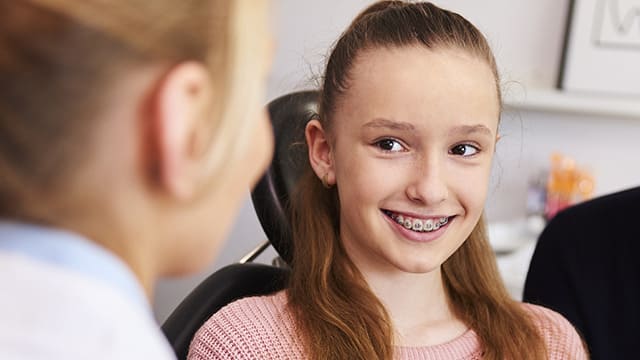How Long Will It Take to Remove the Braces?
The good news is that it takes much less time to remove them than it took getting the braces on. Getting braces removed typically takes around an hour, but it does depend on the case. Your child's orthodontist must dissolve the glue enough to take off the brackets and then clean the rest of the bonding glue off your child's teeth. There may be some light pressure during the removal procedure, and some patients report feeling a little uncomfortable.
What to Do Before Getting Braces Off?
Your child's orthodontist will give you clear instructions leading up to the appointment. However, ensuring your child brushes their teeth and cleans between their teeth on the day of the appointment will help the process go smoothly.
Will the Braces Damage Their Teeth?
Some people develop discolorations when they wear braces. These white spot lesions form because of a buildup of plaque on the teeth that changes the enamel's color. However, your dental professionals can treat these white spot lesions by cleaning the teeth and then applying a fluoride gel or varnish to the area to reverse the lesion. Some people report some tooth or gum sensitivity after the braces have been placed on the teeth. Further, your child may think their teeth feel 'weird' or 'slippery,' but they will get used to it!
Does My Child Have to Wear a Retainer?
Your child's teeth will still need some support after the orthodontist removes the braces. According to the KidsHealth blog by Nemours Children's Health System, the retainer will hold the teeth to maintain the alignment. The length of treatment depends; your orthodontist may require your child to wear a retainer for up to three months full-time and then switch to wearing it at night. However, there are some cases where patients wear their retainers indefinitely. Your orthodontist should inform you of this so that it won't come as a surprise on removal day.
Although wearing a retainer might be uncomfortable or an embarrassment for your child, it's important to remind them that it's an essential part of tooth alignment. Wearing the retainer makes it much less likely that they will need to get braces a second time.
How Should My Child Care for Their Teeth After Braces?
Regular visits to your dental professional and a proper oral hygiene routine at home are essential for keeping the teeth and gums healthy. Brush twice a day with fluoride toothpaste and clean between the teeth with floss, flossers, or interdental brushes once a day to remove food debris and plaque.
Your child's dental professionals may recommend special oral care products, such as therapeutic mouthrinses to help heal any mouth sores, fluoride treatment for cavity prevention, and prescriptive fluoride toothpaste for enamel remineralization of the teeth depending on their oral care needs.
Schedule regular cleanings and checkups with your child's dental hygienist and dentist twice a year after the braces come off. Regular check-ins with the dentist mean that they will catch any potential issues early. It's also a good idea to check in with the orthodontist regularly. Your child's orthodontist can tell you if their retainer is working or if it needs adjustment.
You and your child have invested a lot of time and energy into their smile. The braces removal procedure will be fast and relatively simple. Don't forget to follow your orthodontist's care plan. Ensure your child keeps up their oral hygiene routine and wears the retainer to help the results last a long time.
Oral Care Center articles are reviewed by an oral health medical professional. This information is for educational purposes only. This content is not intended to be a substitute for professional medical advice, diagnosis or treatment. Always seek the advice of your dentist, physician or other qualified healthcare provider.
ORAL HEALTH QUIZ
What's behind your smile?
Take our Oral Health assessment to get the most from your oral care routine
ORAL HEALTH QUIZ
What's behind your smile?
Take our Oral Health assessment to get the most from your oral care routine















